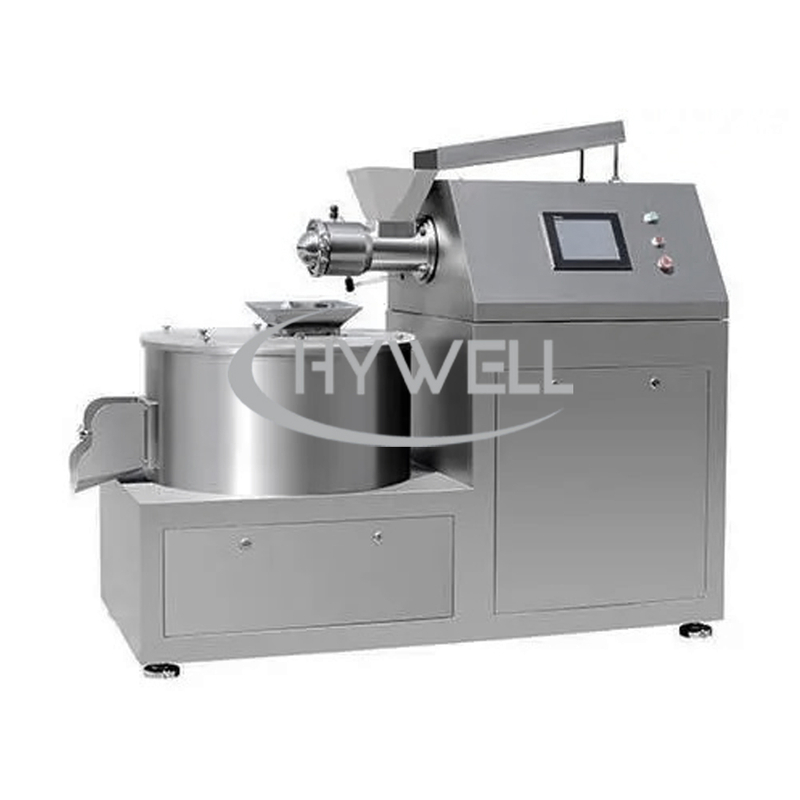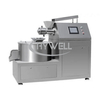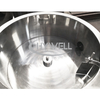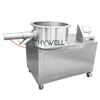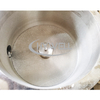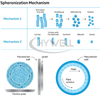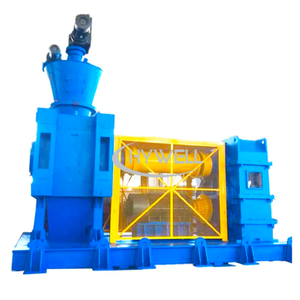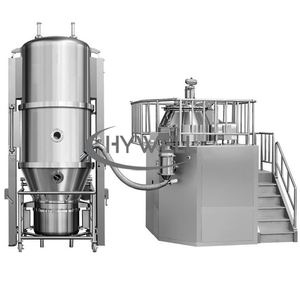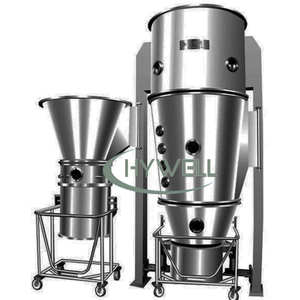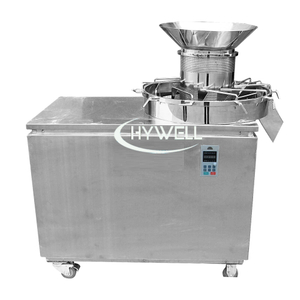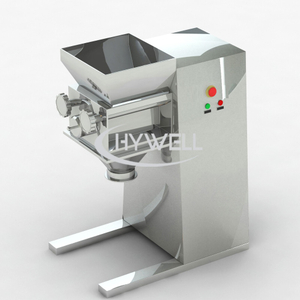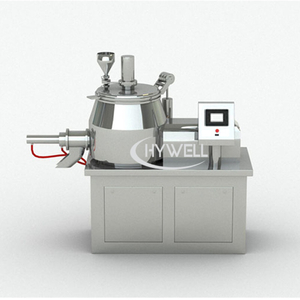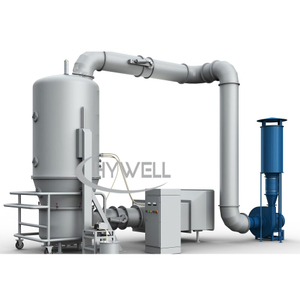Centrifugal Spheronizer Theory
Centrifugal spheronizer uses the centrifugal principle. When cylindrical granules go through high speed rotation with special grooved turning disc, cylindrical granules proceed to even centrifugal, forming a twisted ropelike circulation. The graduation spread of groove enables the granules to achieve extremely high quality spheroids or pills. With high speed rotation disc, the granules are formed into uniform spheroid. The yield is more than 90%. It reduces environmental dust pollution during the process.
Working Principle of Centrifugal Spheronizer
The working principle of a centrifugal spheronizer involves two key processes: wet granulation and spheronization. Initially, a wet granulation process is employed to create granules by blending active ingredients with binding agents and other excipients. The wet granules are then fed into the pellet spheronizer, which comprises a rotating disc or drum.
As the granules enter the Spheronization, the centrifugal forces generated by the rotating disc push the granules outward, causing them to collide with each other. This collision leads to the rounding of the granules, transforming them into spherical particles. Simultaneously, the wet granules are dried through the application of heated air or gas, resulting in solidified spherical particles.
A centrifugal Spheronization machine operates on the principle of centrifugal force and mechanical shear. The equipment consists of a rotating disk or plate with a curved surface and a liquid spraying system. Here's a step-by-step explanation of the working principle:
1. Wet Granule Loading
The wet granules are loaded onto the rotating disk or plate of the spheronizer machine.
2. Centrifugal Force
As the disk rotates, the wet granules are propelled towards the periphery of the plate due to centrifugal force.
3. Liquid Spraying
Simultaneously, a liquid binder or coating solution is sprayed onto the granules. This liquid helps in binding the particles together and forming spherical shapes.
4. Mechanical Shear
The curved surface of the disk creates a mechanical shear effect on the wet granules. This shearing action breaks down the larger granules, removes irregularities, and promotes the formation of spherical pellets.
5. Drying and Hardening
After the spheronization process, the spherical pellets are dried and hardened to ensure their stability and strength.
 Centrifugal spheronizer
Centrifugal spheronizer

Centrifugal spheronizers

Centrifugal spheronizers
How to get Spherical Pellets by Granulator and Centrifugal Spheronizer?
Video of Working Mechanism of Centrifugal Spheronizers
Centrifugal Spheronizer Specifications
Specification | QL-300 | QL-400 | QL-500 | QL-700 | QL-1000 | QL-1300 |
|
Power(Kw) | 0.75 | 2.2 | 3 | 3.7 | 5.5 | 7.5 |
|
Time (Min/batch) | 3-5 | 3-5 | 3-5 | 3-5 | 3-5 | 3-5 |
|
Capacity(kg/h) | 2.5-4 | 5-8 | 10-15 | 15-20 | 20-25 | 25-30 |
|
1.Hywell machinery reserves the right to the design without notice 2.All specifications of rapid mixer granulator are as accurate as is reasonably possible, but they are not binding. |
|
|
Centrifugal Spheronizer Applications
The pharmaceutical industry extensively utilizes centrifugal spheronizer machines for various applications. One of the primary applications is in the production of pharmaceutical pellets or microspheres. Pellets offer advantages such as controlled release of drugs, improved bioavailability, and ease of encapsulation. Additionally, the spheronization process enables the uniform coating of pellets, enhancing their functional properties.
Moreover, the pharmaceutical industry employs centrifugal spheronizers for the production of multiparticulate dosage forms, such as granules and beads. These multiparticulates exhibit improved drug stability, reduced risk of dose dumping, and enhanced patient compliance.
Centrifugal spheronization equipment finds application in various other industries, including:
1. Pharmaceutical Industry
Spheronized pellets are commonly used in the development of controlled-release oral drug formulations, where they ensure a prolonged and consistent release of the active ingredient.
2. Chemical Industry
Spheronization equipment is utilized for catalyst manufacturing, producing uniformly shaped catalyst particles with improved reactivity.
3. Food Industry
Centrifugal spheronizers are employed in the production of food products like breakfast cereals, where they create uniform and aesthetically pleasing shapes.
4. Agricultural Industry
Spheronized granules are used in the production of fertilizers and soil amendments, ensuring controlled nutrient release and easy application.
Pellet Production Line by Centrifugal Spheronizer
The centrifugal spheronizer machine is the main equipment for making pellets. Generally, the pellet production line includes wet mixing, granulation, spheronizer machine, drying, screening, coating (selection), and packaging machine. Specifically the pellet machine line including those equipment? The following is a detailed introduction:
1. High-shear mixer: powder and binder are evenly mixed.
2. Wet granulator: There are usually three types of granulating equipment, such as a swing granulator, a rotary basket granulator, and an extruder. The main function is to make the wet powder into particles of different sizes.
3. Centrifugal spheronizer: the wet particles are made into spherical pellets
4. Fluid bed dryer: it use to dry the ball shape pallet.
5. Vibrating sieving machine: uses to obtain uniform-size pellets
6. Fluid bed dryer coater: The pellets can be coated, mainly for the color of the pellets or the slow-controlled release.
Advantages of Centrifugal Spheronizer
Ball granules pelletizer offers several advantages over traditional particle processing methods. Firstly, it enables the production of spherical particles with a high degree of uniformity, shape consistency, and narrow size distribution. This characteristic is crucial for applications that require precise control over particle properties.
Furthermore, centrifugal spheronizers offer flexibility in the selection of materials and processing parameters. They can accommodate a wide range of materials, including heat-sensitive compounds. The adjustable parameters allow customization of particle size, density, and porosity, catering to specific formulation requirements.
1. Improved Flow Properties
The spherical pellets produced through centrifugal spheronization have excellent flow properties, making them easier to handle during manufacturing processes such as blending, filling, and tableting.
2. Uniform Particle Size Distribution
Spheronization ensures a uniform particle size distribution, resulting in consistent drug potency and dosage uniformity.
3. Customizable Characteristics
The process allows for the customization of pellet size, shape, and density, making it suitable for a wide range of applications and formulations.
4. Efficient Scale-up
Centrifugal spheronizers are designed to accommodate large-scale production, ensuring a seamless transition from laboratory-scale to commercial-scale manufacturing.

Spherical Pellets

Spherical Pellets

Pellets
Limitations and Challenges of Centrifugal Spheronizer
While centrifugal spheronization presents numerous benefits, it also has limitations and challenges. One of the challenges is the potential generation of fine dust during the process, which may require additional measures for containment and operator safety. Additionally, certain materials may exhibit poor spheronization behavior, requiring optimization of formulation and process parameters.
Emerging Trends in Centrifugal Spheronization Machine
Centrifugal spheronization is a continuously evolving field with emerging trends that aim to improve efficiency, enhance particle properties, and expand application possibilities. One prominent trend is the integration of process analytical technologies (PAT) into centrifugal spheronizer systems. PAT enables real-time monitoring and control of critical process parameters, ensuring consistent product quality and reducing batch-to-batch variability.
Another emerging trend is the incorporation of advanced automation and robotics in centrifugal spheronization processes. Automated systems streamline production, minimize human intervention, and improve overall process efficiency. Robotics assist in tasks such as granule feeding, disc rotation, and product discharge, optimizing the entire spheronization process.
Furthermore, research is focused on developing innovative binding agents and excipients that enhance the spheronization process. New materials with improved binding properties and compatibility with different active ingredients are being explored. These advancements contribute to the production of high-quality spherical particles with enhanced drug release profiles and therapeutic efficacy.
Future Prospects and Innovations for the Centrifugal Spheronizer
The future prospects of centrifugal spheronization are promising, with ongoing research and development aimed at addressing current limitations and exploring new applications. Improved containment systems and dust control measures will ensure operator safety and minimize environmental impact. Further optimization of process parameters and equipment design will lead to higher production yields and reduced energy consumption.
Moreover, the combination of centrifugal spheronization with other technologies, such as fluid bed drying and coating, opens up new avenues for the production of functional particles with tailored properties. The integration of continuous manufacturing principles in centrifugal spheronizer systems will enable seamless and efficient production of spherical particles on a large scale.
Factor of the Centrifugal Spheronizer
1. Producing time per batch is only 5-10 mins.
2. Rotary disc for different diameter granule production.
3. All designs and manufacture are qualified by cGMP standards and FDA requirements.
4. The centrifugal spheronization machine has a complete discharge and easy cleaning
5. Time-saving, fast exchange of the container(on small models as an Option), due to simple and fast mounting of the container
6. Highly polished inner and outer surfaces of the barrel, no dead comer, easy to discharge materials, easy to clear, no cross-contamination. Confining the requirement of GMP.
7. The centrifugal spheronizer machine has Low noise and good seal
8. The centrifugal spheronizer has an enclosed structure, without overflow of power dust
9. The pellet machine has smooth running, reliable performance, and easy operation
10. The pellet machine connects with the fluid bed dryer by vacuum conveying.
11. Automatic PLC control system.
Factors Affecting Spheronization by the Centrifugal Spheronizer
Several factors influence the spheronization process, including:
Wet Granule Formulation
The composition and properties of the wet granules, such as binder concentration, particle size distribution, and rheological characteristics, affect the spheronization outcome.
Process Parameters
Variables such as rotation speed, spraying rate, temperature, and drying conditions significantly impact the formation and quality of the spherical pellets.
Equipment Design
The design and configuration of the centrifugal spheronizer, including disk curvature, disk speed, and liquid spraying mechanism, play a crucial role in achieving desired pellet characteristics.
Common Challenges in Centrifugal Spheronizer
While spheronization is a widely used technique, it comes with certain challenges, including:
Agglomeration
Improper wet granule formulation or excessive liquid spraying can lead to agglomeration of the particles, resulting in irregular pellet shapes or poor flow properties.
Inconsistent Spheronization
Variations in wet granule properties or process parameters can cause inconsistent pellet formation, leading to a wide particle size distribution.
Overheating
Excessive heat during the drying phase can cause pellet deformation or cracking, affecting the overall quality of the spheronized particles.
Binder Compatibility
The selection of an appropriate binder or coating solution is crucial to ensure compatibility with the active ingredient and achieve the desired pellet characteristics.
Centrifugal Spheronizer Construction Material
Hywell Machinery is able to offer our QL series Centrifugal spheronization machine with contact parts to be built in SS304, SS316L, Titanium, Duplex stainless steel, etc. For the control system of Centrifugal spheronizer, Hywell has choices on push button, PLC+HMI, and so on, and For the main electrical components of the Centrifugal spheronizer, it can choices the famous brand.
Centrifugal spheronization Machine Conclusion
Centrifugal spheronization has revolutionized particle processing, offering a reliable and efficient method to produce spherical particles with precise control over their properties. Its applications in the pharmaceutical industry, along with its advantages in terms of particle uniformity and customization, make it a valuable technology for drug formulation and delivery.
As the field continues to evolve, embracing emerging trends and innovations, centrifugal spheronization holds immense potential for further advancements in particle processing. With ongoing research and development, we can expect to witness new breakthroughs, expanded applications, and increased efficiency in this exciting area of particle engineering.
FAQs
What is the purpose of spheronization in the pharmaceutical industry?
Spheronization in the pharmaceutical industry is primarily used to convert irregularly shaped granules into spherical particles. This process improves drug stability, enhances drug release profiles, and enables better encapsulation and coating of pellets.
Are there any safety concerns associated with centrifugal spheronization?
Centrifugal spheronization may generate fine dust particles during the process. To address safety concerns, appropriate containment systems and dust control measures should be implemented to ensure operator safety and minimize environmental impact.
Can centrifugal spheronization be used for heat-sensitive compounds?
Yes, centrifugal spheronizers can accommodate heat-sensitive compounds. The process parameters can be adjusted to minimize the exposure of the materials to excessive heat, ensuring the integrity of the active ingredients.
What are the advantages of using automation and robotics in centrifugal spheronization?
Automation and robotics in centrifugal spheronization improve process efficiency by reducing human intervention and streamlining production. Robotic systems can perform tasks such as granule feeding, disc rotation, and product discharge, leading to increased productivity and consistency.
How does centrifugal spheronization contribute to controlled drug release?
Centrifugal spheronization enables the production of pellets with controlled drug release profiles. By achieving uniform particle size and shape consistency, the spheronization process ensures consistent drug release
English
Русский
العربية
Français
Español
Português
Deutsch
italiano
日本語
한국어
Nederlands
Tiếng Việt
ไทย
Polski
Türkçe
ພາສາລາວ
Bahasa Melayu
Filipino
Bahasa Indonesia
magyar
Română
Čeština
қазақ
Српски
हिन्दी
فارسی
Slovenčina
Slovenščina
Norsk
Svenska
українська
Ελληνικά
Suomi
Հայերեն
עברית
Dansk
اردو
বাংলা
Hrvatski
Afrikaans
Gaeilge
Eesti keel
Māori
नेपाली
Oʻzbekcha
latviešu
Azərbaycan dili
Беларуская мова
Български
ქართული
Kurdî
Кыргызча

 简体中文
简体中文